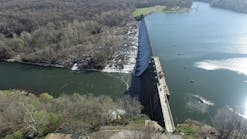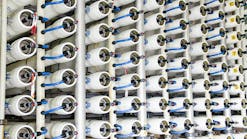The invention of the furnace in the 1800s transformed the industrial world by utilizing various materials to create new and better products. Water tanks and the pipes that accompany them are an excellent example how technology can transform an industry. Before the invention of the furnace, water tanks and pipes were mostly made of wood and some with concrete. Standard dimensions did not exist for either, making repairs and connections difficult. The first furnace made wrought-iron pipe available, and the open hearth furnace made steel in larger quantities more available.
This, in turn, helped create standard dimensions that made the pipe easier to connect and repair. Riveted steel pipe started replacing the wood. Then, the development of Lock-Bar and electric welding changed the process of connecting steel. The welded steel required fewer pieces and the production was much faster with smaller more efficient seams. Welded steel replaced the riveted, and became the most attractive means to create pipe and tanks.
While steel does have many qualities that make it desirable; steel does corrode. When corrosion occurs, the thickness of the steel wall can be compromised. If the pipe’s wall thickness is not adequate enough, the pipe can rupture or spring leaks. Corrosion control coatings are applied to most piping to slow the time of deterioration, but the pipes must still be inspected and coated regularly to maintain its longevity. Thankfully, the AWWA, NFPA, and OSHA have devised a system of codes and standards that contain several recommendations on pipe inspections, and the NFPA 25 also contains a helpful chart that list each type of pipe and timetable for inspecting.
Most water tanks contain an inlet, outlet, and overflow pipe made from steel. The inlet and outlet pipes should be two different pipes if the tank is used for drinking water, because a silt stop needs to be placed on the end of the outlet pipe to help eliminate sediment and contamination. Over-the-top fill pipes are recommended on many tanks to help prevent the formation of ice, create better circulation, and prevent backflow.
Overflow pipes are installed on tanks to protect the tank from overpressure and overload. If the pumps or altitude valve fail to shut off during tank filling, the extra water must be evacuated from the tank before too much pressure is built up. An overflow pipe should not be connected directly to a sewer or a storm drain because the discharge would not be visible. AWWA does not recommend the use of an internal overflow, because if an overflow failure occurs it can empty the tank.
AWWA states that, “A properly operated tank should not overflow during normal operation. An overflowing tank is considered an emergency condition, and the malfunction causing the overflow should be determined and corrected as soon as possible.”
Overflow pipes should be properly sized and extend to ground level, complete with a weir box. If an underground drain is present, it should be sealed and an air break installed. A screen and flapper valve, in accordance with AWWA, NFPA 22, OSHA, and EPA, needs to be installed over the opening of the overflow pipe to prevent the ingress of contaminates into the water supply. A splash pad directs the water away from the tank’s foundation and is required by AWWA.
Different types of water tanks can be equipped with other pipes. For example, if the tank is an elevated water tank it will also contain a riser pipe used to transfer the water to and from the tank container bowl. The riser pipe should also contain a drain valve, manway, access ladder, and safety climb device. Pipe insulation should be used inside dry risers to prevent the pipes from freezing, and any other pipe connected to the tank should also follow the AWWA standards that state, “design of the piping system connected to the tank shall consider the potential movement of the connection points during earthquakes and provide sufficient flexibility to avoid release of the tank contents due to failure of the piping system. The piping system and supports shall be designed so as not to impart significant mechanical loading on the attachment to the tank.”
The location of each individual tank is critical information for earthquake protection and freezing. If the tank is located above the isothermal line it should be heated as NFPA 22-43 states: “Tanks that are subjected to freezing shall be heated.” If the tank contains a heater or steam pipe, these, too, must also be inspected and replaced regularly.
Technology changed the material, process, and expectations of pipe, creating a new and specialized field of study. Today, professionals are called to inspect, repair, and replace pipes on water tanks because they have been educated, certified, and received the proper safety training necessary to perform the work.


